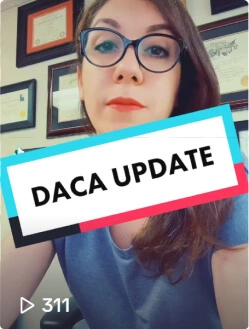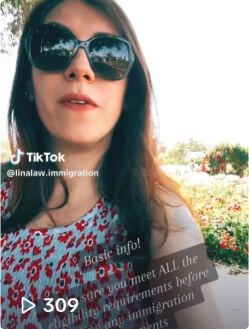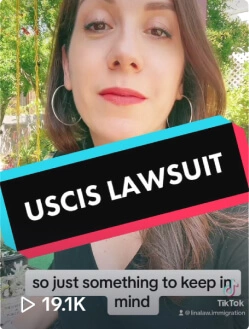Humanitarian reinstatement is a form of relief available for the principal beneficiary of an approved Form I-130, Petition for Alien Relative, in cases where the petitioner, usually a family member, has passed away.
This provision addresses the challenging circumstances that can arise when a petitioner, who is often a close family member, such as a spouse or parent, has sponsored an immigrant but sadly passed away before the immigration process is completed.
Humanitarian reinstatement allows the principal beneficiary to continue their immigration journey based on the approved petition, helping to maintain family unity in difficult situations.
If you find yourself in such a situation, it’s advisable to seek guidance from experienced immigration lawyers. At The Law Office of Lina Baroudi, we can help you understand the specific procedures and requirements for requesting humanitarian reinstatement in your case.
What is Humanitarian Reinstatement?
Humanitarian reinstatement helps eligible beneficiaries whose approved immigrant petitions have been revoked due to the petitioner’s death, providing them a chance to continue their immigration process.
However, not every beneficiary of an immigrant petition can apply for this relief; it only applies when the petitioner has died after the petition was approved but before the beneficiary becomes a permanent resident. Humanitarian reinstatement cannot be granted if the petitioner passes away while the petition is still pending.
Eligibility Criteria for Humanitarian Reinstatement
To apply for humanitarian reinstatement, you must be the principal beneficiary of an approved Form I-130. Additionally, if you were originally required to have Form I-864, Affidavit of Support, and your petitioner has passed away, you’ll need to obtain a new Form I-864 from a substitute sponsor.
This substitute sponsor should meet the following criteria:
- Be a U.S. citizen, national, or lawful permanent resident.
- Be at least 18 years old.
- Have a qualifying relationship with you, which includes being your spouse, parent, mother-in-law, father-in-law, sibling, child, son, daughter, son-in-law, daughter-in-law, sister-in-law, brother-in-law, grandparent, grandchild, or legal guardian.
It’s essential to understand that humanitarian reinstatement is not an automatic process; it’s discretionary. In making a decision, immigration authorities weigh various factors.
They consider both positive and negative aspects before determining whether to grant this relief. In essence, your request must demonstrate that the benefits of granting humanitarian reinstatement outweigh any potential drawbacks.
How to Apply for Humanitarian Reinstatement
The process to request humanitarian reinstatement doesn’t involve any forms or fees. It starts with a written request and supporting documents sent to the USCIS office that initially approved the petition.
Below are the steps involved:
- Prepare a Written Request: Write a formal letter addressed to the USCIS office that originally approved the petition. In your request, clearly state your name and the name of your deceased petitioner.
- Include Important Information: Make sure to include the receipt number of the petition, which can be found on the receipt notice. If you have an Alien Registration Number (A-Number), include it in your request. Also, if your deceased relative had an A-Number, provide it.
- Submit supporting documents: Attach your relative’s death certificate to your request. If the death certificate is not in English, you must include a certified translation. This document is essential to prove the death of your petitioner.
- Obtain Form I-864: You must also include a Form I-864 from your substitute sponsor. This form is a legally binding contract to ensure that you will not become a public charge in the United States.
- Provide Evidence of Positive Factors: To demonstrate that a favorable exercise of discretion is warranted, present evidence highlighting your case’s positive aspects. Some factors to consider include:
– Impact on Family: Emphasize how the reinstatement would benefit your family living in the United States, especially if they are U.S. citizens, lawful permanent residents, or others lawfully present.
– Advanced Age or Health Concerns: If you or any following-to-join family members of the beneficiary have advanced age or health concerns, provide documentation to support this claim.
– Lengthy Residence: Show evidence of your lawful residence in the United States for a significant period of time.
– Ties to Home Country: Explain any ties or lack thereof to your home country, highlighting the reasons why returning would be challenging or detrimental.
– Government Processing Delays: If you have experienced unusually lengthy government processing delays, mention this in your request and provide supporting documentation if available.
– Additional Factors: Include any other factors that you believe weigh in favor of reinstatement, along with supporting documentation. These could be personal circumstances or unique situations that demonstrate the need for humanitarian reinstatement.
It is important to note that the list above is not exhaustive, and you should include any other relevant factors that support your request. Providing strong and compelling evidence will increase the chances of a successful humanitarian reinstatement application.
What Happens After Submitting a Humanitarian Reinstatement Request?
Since humanitarian reinstatement is completely up to the discretion of USCIS, there is no set timeline to receive a decision. In fact, some humanitarian reinstatement requests can take years to receive a decision.
If your request is approved, you’ll feel a wave of relief when your humanitarian reinstatement request is approved, reconnecting you with your loved ones and offering a glimmer of hope in difficult times.
However, it’s crucial to understand that this approval doesn’t automatically grant you an immigrant visa or adjustment of status. You will still need to go through further steps like submitting Visa Applications or Adjustment of Status Applications. Equally important are the financial implications tied to these subsequent procedures, which include government filing fees and potential legal representation costs.
On the other hand, if your request is denied, it can be a devastating setback, as new petitions will need to be filed on behalf of the beneficiaries of the revoked petition
It’s vital to consult with a family immigration attorney who can provide guidance tailored specifically to your situation throughout this complex process.
Legal Issues Involved in Humanitarian Reinstatement
The path to achieving humanitarian reinstatement often presents challenges and legal considerations. On one hand, you may encounter obstacles related to finding a substitute sponsor or demonstrating compliance with immigration laws.
It’s not enough to merely state the facts of your case; you must present compelling evidence that substantiates your request for humanitarian reinstatement. Because the request for humanitarian reinstatement is purely discretionary, you must convince USCIS that all of the positive factors in your case outweigh any negative factors.
This is why working with an attorney is so important. An experienced immigration attorney can guide you through the complexities of the process, help ensure your application is well-prepared, and provide valuable legal insights to enhance your chances of success.
If you or someone you love is navigating the immigration process, contact The Law Office of Lina Baroudi today and take the next step toward achieving your goals.















